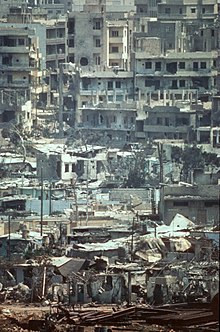
Back مجزرة تل الزعتر Arabic مدبحة تل الزعتر ARZ Masacre de Tel al-Zaatar Spanish کشتار تل زعتر Persian Massacre de Tel al-Zaatar French טבח תל א-זעתר HE Pembantaian Tel al-Zaatar ID Massacro di Tell al-Za'tar Italian Komkujiya Tilzeterê Kurdish Massakren i Tel el Zaatar NB
| Tel al-Zaatar massacre | |
|---|---|
| Part of the Lebanese Civil War | |
 The destroyed camp (from the ICRC archives) | |
| Location | Tel al-Zaatar camp, Dekwaneh, Beirut |
| Date | 4 January – 12 August 1976 |
| Target | |
Attack type | Massacre |
| Deaths | 3,000 Palestinians killed[1] |
| Perpetrators | |
| Motive | Anti-Palestinian sentiment |
The Tel al-Zaatar massacre was an attack on Tel al-Zaatar (meaning Hill of Thyme in Arabic), a UNRWA-administered refugee camp housing Palestinian refugees in northeastern Beirut, that ended on August 12, 1976 with the massacre of 1,500[2][3][4] to 3,000 people.[5] The siege began in January of 1976 with an attack by Christian Lebanese militias led by the Lebanese Front as part of a wider campaign to expel Palestinians, especially those affiliated with the opposing Palestine Liberation Organization (PLO) from northern Beirut.[6] After five months, the siege turned into a full-scale military assault in June and ended with the massacre in August 1976. [7]
- ^ Price, Daniel E. (1999). Islamic Political Culture, Democracy, and Human Rights: A Comparative Study. Greenwood Publishing Company, ISBN 978-0275961879, p. 68.
- ^ Lisa Suhair Majaj, Paula W. Sunderman, and Therese Saliba Intersections Syracuse University Press ISBN 0815629516 p. 156
- ^ Samir Khalaf, Philip Shukry Khoury (1993) Recovering Beirut: Urban Design and Post-war Reconstruction, Brill, ISBN 9004099115 p. 253
- ^ Younis, Mona (2000) Liberation and Democratization: The South African and Palestinian National Movements University of Minnesota Press, ISBN 0816633002 p. 221
- ^ Cite error: The named reference
:65was invoked but never defined (see the help page). - ^ United States Army Human Engineering Laboratory (June 1979). Military Operations in selected Lebanese built-up areas, 1975–1978 (PDF). Technical Memorandum 11–79 (Report). Archived (PDF) from the original on February 1, 2014.
- ^ Khoury, Elias (2012). "Rethinking The Nakba". Critical Inquiry. 38 (2): 250–266. doi:10.1086/662741. S2CID 162316338.
© MMXXIII Rich X Search. We shall prevail. All rights reserved. Rich X Search